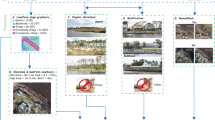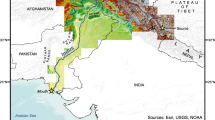Abstract
High precision elevation measurements using DGPS were carried out along three representative transects for the “Great Ear” area, a dry salt lake within the Lop Nor basin. Results indicate that the Lop Nor basin is only 5.2 m deep and its lowest point occurs at the center of the “Great Ear”. In addition, the basin is asymmetric — steeper in the southwest (0.19‰) and gentler in the northeast (0.09‰). Points along the same “Great Ear” ring were found to have an identical elevation value, but different when from different ones (lower towards the center). The spacing of the “Great Ear” rings was found to be closely related with the surface steepness. The closer the “Great Ear” rings are spaced, the steeper the ground surface, and vice versa. These findings support the argument that the “Great Ear” rings are the former shoreline trails left behind by Lop Nor water during the last few episodes of recession towards its total dry up. A comprehensive analysis of the high precision elevation data, historical accounts, aerial and satellite photographs and imagery, and official topographic maps of the study area suggests that the “Great Ear” area in the Lop Nor basin was incorrectly mapped as being covered by a great body of water on the 1963 topographic maps. A re-interpretation of the 1958 aerial photographs and newer remote sensing imagery indicated that the “Great Ear” ring structure was already in place in 1958 and it continued to appear on the subsequent remote sensing data without any major changes. It is estimated that lake water in the “Great Ear” area of the Lop Nor basin disappeared between the late 1930s and early 1940s.
Similar content being viewed by others
References
Hedin S A, translated by Jiang H. The Wandering Lake (in Chinese). Urumqi: Xinjiang People’s Publisine House, 2000
Hedin S A, translated by Wang A H. Exploration in Lop Nur (in Chinese). Urumqi: Xinjiang People’s Publisine House, 1997
Huntington E. The Pulse of Asia—A Journey in Central Asia Illustrating the Geographic Basis of History. Boston and New York: Houghton Mifflin Company, 1907
Stein M A. Ruins of Desert Cathay—personal narrative of explorations in Central Asia and western most China. Limited, St. Martin’s Street, London: MacMillan and Co, 1912
Yang Q. The Lop Nur is not a wandering lake: views from the evolution of Lop Nur. J Lake Sci (in Chinese), 2004, 16(1): 1–9
Zhou T R. On the question about the wandering of the Lop Nur lake. J Beijing Normal Univ (Natural Sci) (in Chinese), 1978, (3): 34–40.
Zhao Y J, Xia X C, Wang F B, et al. Preliminary study on the geomorphical characteristic and formation cause of modern salt crust type in Lop Nur region. Arid Land Geog (in Chinese), 2005, 28(6):795–799
Cheng Y D. Walk to the Lop Nur Lake When It Was Filled With Water (in Chinese). Beijing: Kunlun Press, 2005
Fan Z L, Li P Q, Zhang B Q. The salt crust of the Lop Nur. In: Xia X C, eds. Scientific Investigation and Research in the Lop Nur Lake Region (in Chinese). Beijing: Science Press, 1987. 141–156
Xia X C, Zhao Y J. Some latest achievements in research in the environment and evolution of Lop Nur region. Sci Found Chin (in Chinese). 2005, 4: 196–200
Xie L W, Li F, Li B H, et al. The genesis of the ring salt crust images of the Lop Nur salt lake. Sedim Geol Tethyan Geol (in Chinese), 2004, 4(4): 76–80
Ma L C, Li B G, J P A, et al. The correlation between the electromagnetic induction measurements and pixel values associated with the “Great Ear” rings in Lop Nur. Chin J Geophys (in Chinese), 2006, 50(2): 651–654
Yan S, Mu G J, Xu Y Q, et al. Quaternary environmental evolution of the Lop Nur region China. Acta Geog Sin (in Chinese), 1998, 53(4):332–340
Zheng M P, Qi W, Wu S Y, et al.The prospect analysis of potash search and sedimentary environment in Lop Nur salt lake since the late Pleistocene, Chin Sci Bull (in Chinese), 1991, (23): 1810–1813
Wang M L. Potassium Resources in the Lop Nur Salt Lake (in Chinese). Beijing: Geological Publishing House, 2001
Sarti F, Arkin Y, Chorowicz J, et al. Assessing pre-and post-deformation in the southern Arava Valley segment of the Dead Sea Transform, Israel by differential interferometry. Remote Sens Environ, 2003, 86(2): 141–149
Dauteuil O, Bouffette J, Tournat F, et al. Holocene vertical deformation outside the active rift zone of north Iceland. Tectonophysics, 2005, 404: 203–216
Berthier E, Vadon H, Baratoux D, et al. Surface motion of mountain glaciers derived from satellite optical imagery. Remote Sens Environ, 2005, 95(1): 14–28
Jentzsch G, Punongbayan R S, Schreiber U, et al. Mayon volcano, Philippines: change of monitoring strategy after microgravity and GPS measurements from 1992 to 1996. J Volcannol Geotherm Res, 2001, 109: 219–235
Teatini P, Tosi L, Strozzi T, et al. Mapping regional land displacements in the Venice coastland by an integrated monitoring system. Remote Sens Environ, 2005, 98(4): 403–413
Squarzoni C, Delacourt C, Allemand P, Differential single-frequency GPS monitoring of the La Valette landslide (French Alps). Eng Geol, 2005, 79: 215–229
Corsini A, Pasuto A, Soldati M, et al. Field monitoring of the Corvara landslide (Dolomites, Italy) and its relevance for hazard assessment. Geomorphology, 2005, 66: 149–165
Zhong J P, Qiu H L, Dong X G, et al. Discussion on the dried-up time of the Lop Nor Lake. Arid Land Geog (in Chinese), 2005, 28(1): 6–9
Chen Z Q. Lop Nur Lake and Lop Nur Desert. Acta Geog Sin (in Chinese), 1936, 3(1): 18–49
Hong J L, Lu R Z. The estimation and the distribution perfects of the evaporation of brine in the four big sea-salt areas in the northern China. Geog Res (in Chinese), 1988, 7(24): 17–27
Guan X Y, Ren J R, Ye T W. A preliminary study on the enlarged evaporation test at the Dacaidan salt lake brine site. Jilin Geol (in Chinese), 2005, 24(2): 66–71
Author information
Authors and Affiliations
Corresponding author
Additional information
Supported by the National Natural Science Foundation of China (Grant No. 40671080), the Program for Changjiang Scholars and Innovative Research Team in University (Grant No. IRT0412), and the Key Subject of Soil Science Program in Xinjiang
About this article
Cite this article
Li, B., Ma, L., Jiang, P. et al. High precision topographic data on Lop Nor basin’s Lake “Great Ear” and the timing of its becoming a dry salt lake. Chin. Sci. Bull. 53, 905–914 (2008). https://doi.org/10.1007/s11434-008-0003-4
Received:
Accepted:
Published:
Issue Date:
DOI: https://doi.org/10.1007/s11434-008-0003-4




